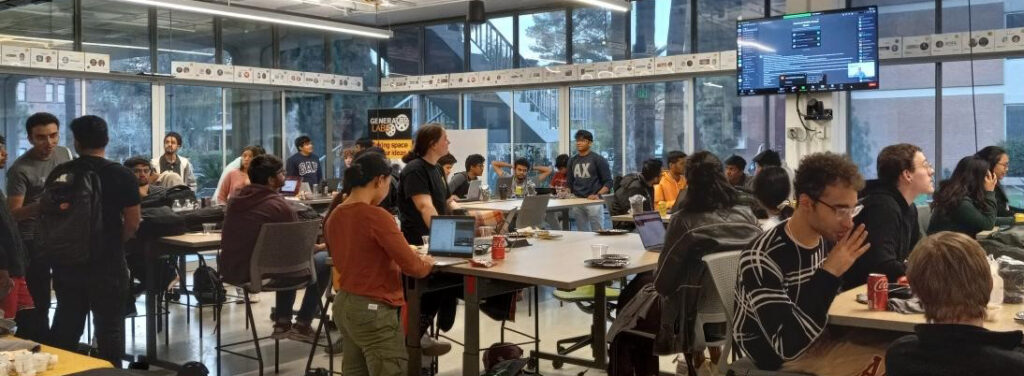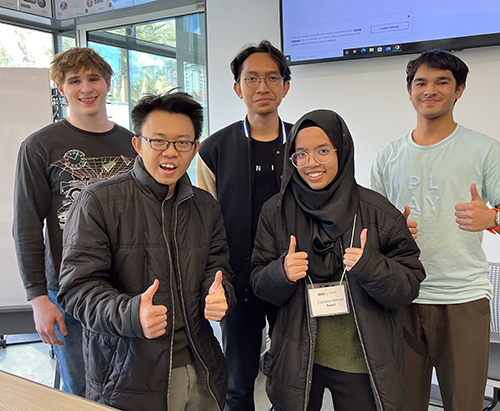Undergraduate experience

During the course of a weekend in February, over 115 students from 11 higher education institutions met to develop innovative solutions to protect public access areas in the United States. Public access areas include anywhere that large numbers of people gather, such as sporting and cultural events, bus and rail terminals, shopping malls and schools. The student teams were challenged to develop solutions for three scenarios that could impact public access areas; 1) How do we guide crowds to good decisions during an attack? 2) How do we enable effective and timely communication among stakeholders and responders to allow for oversight and response to an attack and 3) How can we inform and enable civilians to prepare for a drone attack?
Two Department of Homeland Security Centers of Excellence, the Center for Accelerating Operational Efficiency (CAOE) and Soft Target Engineering to Neutralize the Threat Reality (SENTRY), partnered with DHS Science and Technology Directorate (S&T), to host the national multi-school Designing Actionable Solutions for a Secure Homeland (DASSH) student event. DASSH is a design challenge that is similar to a hackathon except instead of coding challenges, DASSH is focused on a multidisciplinary approach to finding real solutions regardless of the method or medium.
This challenge is the fourth year that such an event was hosted by CAOE and the first co-hosted with SENTRY. This partnership between the centers encouraged participation from a diverse student population that comprised students from six Minority Serving Institutions (MSI) including San Diego State University, University of the District of Columbia, Fayetteville State University, Elizabeth City State University and Chapman University.
The weekend challenge started with opening ceremonies including a keynote from Dr. Dimitri Kusnezov, DHS Under Secretary, Science and Technology, Directorate, who gave the students an introduction to the challenges of protecting public access areas and the importance of students in helping with that mission. “We recognize the dedication of these insightful and passionate students who aid in our mission to develop new approaches to the real-world challenge of protecting soft targets in our society. We are grateful to the faculty and staff who have invested so much time and energy into helping these bright and motivated students tackle these real-world issues head-on,” stated Kusnezov.
Admiral George Naccara, retired United States Cost Guard (USCG), former DHS Senior Office and former Chief Security Massachusetts Port Authority, described real-life scenarios that have impacted public access areas and outlined probable future risks. Naccara also remarked on the importance of developing the next generation of homeland security professionals. “This is truly a remarkable opportunity to engage young minds in thinking about the risks and threats and devising innovative approaches to mitigate or minimize these risks,” said Naccara.
The 23 student teams competed for their share of over $55,000 in cash prizes by providing solutions for the challenge scenarios over the three-day event. DASSH concluded with the teams presenting their solutions to a team of both homeland security researchers and government experts. The solutions from the winning teams included mapping optimal evacuation routes using machine learning and artificial intelligence technology, a live emergency response system for application in mass shootings, and a grassroots instructional drone drill training program for teachers.
Students were engaged and enthusiastic during the event. “We can learn more here than we can in a classroom,” said Arizona State University (ASU) undergraduate student Fawwaz Firdaus. “I feel more passionate about doing this than I would my homework.”
Team AzTechs says the big win was worth the “40+-hour adrenaline rush,” according to San Diego State University (SDSU) undergraduate student Christopher Choo. “This has been one of the most exciting opportunities I’ve had in my time in the College of Engineering. Our results are a testament to the success that comes with curiosity and the right team.”
“Participating in this event also gave me a greater appreciation for the work that is done by DHS and the importance of constantly adapting to new and emerging threats,” mentioned University of District Columbia (UDC) graduate student James Fitzgerald. “My perspective on homeland security and the DHS definitely changed after this experience, and I am now more motivated than ever to pursue a career in this field.”
Fellow UCD teammate, graduate student Bob Kingombe felt the similarly, “the most valuable aspects of the program were firstly developing a deeper understanding of the issues involved in ensuring homeland security and the various approaches that can be taken to address them and secondly, gaining a broader perspective on the role of DHS and homeland security in protecting the United States and its population.””
First Place Teams

Scenario 1: How do we guide crowds to good decisions during an attack?
AzTechs – SDSU
Tiber Hernandez, Milan Bujosevic, Elisha Reece, Christopher Choo, Jared Acosta, Douglas Younkin
PAPPA – Presentation Link

Scenario 2: How do we enable effective and timely communication among stakeholders and responders to allow for oversight and response to an attack
Malindo – ASU
Rui Heng Foo, Fawwaz Firdaus, Kalyanam Priyam Dewri, Nathan McAvoy, Camelia Arian Binti Ahmad Nasri
Live Emergency Response System – Presentation Link

Scenario 3: How can we inform and enable civilians to prepare for a drone attack?
The Untouchables – UDC
James Fitzgerald, Bob Kingombe, Jasmine Gibson, Maya Smith
Drown Emergency Drill Training Program
